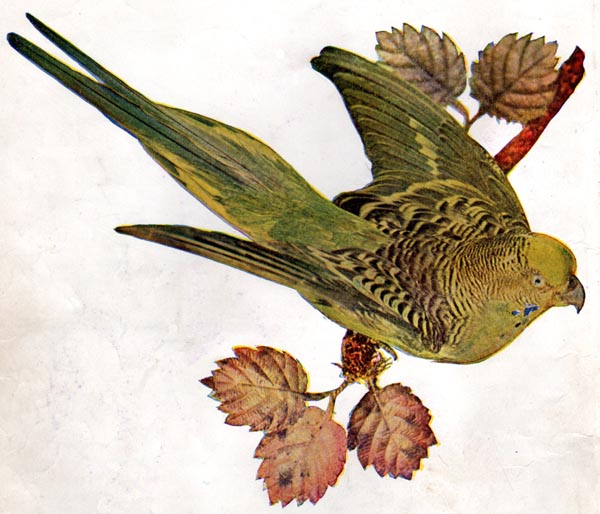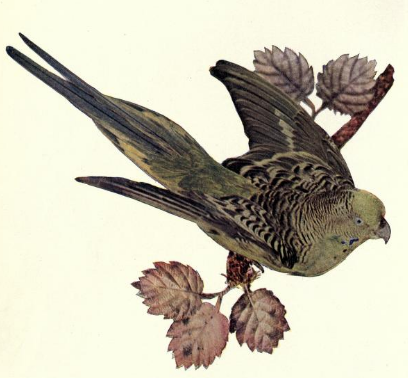Today we review the fifth bird in the January 1897 edition of Birds: A Monthly Serial, or Birds: Illustrated by Color Photography, namely, the Australian Grass Parrakeet. If you are perplexed by the spelling “Parrakeet” instead of “Parakeet,” that is what the magazine uses, so we will use it here too. Today’s bird is a bit less colorful than the first four we covered in the series, but no less charming. Without further ado, let us go down under to learn more about the Australian Grass Parrakeet, or Parakeet in contemporary spelling.
You can follow along with the original Australian Grass Parrakeet content at Project Gutenberg or The Internet Archive.
Parrakeet or Parakeet?
The first thing that caught my attention about the “Parrakeet” section was the spelling. I had only ever seen the name of the bird spelled with one r, not two. Contemporary resources list “parrakeet” as an alternate spelling for “parakeet.” For example, see Collins Dictionary. To get to the bottom of the issue of why an 1897 magazine used the now-less-common two-r spelling, I consulted a couple of near contemporary dictionaries. Therein, I found something interesting.
First, I referred to an edition of The Century Dictionary that was published from 1889-1891. Century used “parrakeet” as the spelling for the primary definition, and listed “parakeet” as an alternate spelling. “Parakeet” has an individual entry that refers the reader to “parrakeet.” I clipped and posted the “parrakeet” definition in its entirety below, with a lovely picture of the par(r)akeet.

Out of curiosity, I then checked Webster’s 1913, which was published about 16 years after the magazine. Webster’s also listed “parrakeet” as the primary spelling and “parakeet” as an alternate spelling. These dictionaries both suggest that “parrakeet” was the more common spelling around the turn of the twentieth century. The dictionaries also list “paroquet” and “paraquet” as additional alternative spellings.
Finally, I consulted by 1952 edition of Webster’s Second New International Dictionary, Unabridged. Webster’s Second was first published in 1932. Webster’s Second has an entry for “parakeet,” but none for “parrakeet.” Moreover, as you can see below, “parrakeet” is not even included as an alternative spelling.

Today, my spelling dictionary for Libre Office informs me that “parrakeet” is an error. While uncommon, it is no error. You cannot always trust those spell check libraries.
For purposes of this article, I will use “Parrakeet” when I am discussing content from the magazine article itself.
The Australian Grass Parrakeet, Illustrated
“Illustrated by Color Photography” is the Birds magazine’s tagline. Thus, we start the Australian Grass Parrakeet section with the magazine’s illustration of the little green bird.

This picture is a proverbial action shot compared to the pictures of the previous birds. The Australian Grass Parrakeet looks like it is about to spring into the air. Since we are The New Leaf Journal, I must also take note of the aesthetic brown leaves in the picture. Well done.
Mr. Australian Grass Parrakeet Sings
The magazine includes a brief statement from the Australian Grass Parrakeet himself. How do we know it is a “he”? Well, Mr. Australian Grass Parrakeet talks about his wife. That seems diapositive to the question. I cannot help but notice that this is the fifth straight time we have heard from a male bird. I can only infer that female birds were very quiet in 1897.
Where Does Mr. Australian Grass Parrakeet Live?
The previous two birds wrote to us from China. One of those birds, the Mandarin Duck expressly began his letter by noting that he was writing from China. You might think then that Mr. Australian Grass Parrakeet would write from Australia. Not so. “A man brought me here.” Where is here? Well,”[i]t is not warm here, as it was where I came from.” The poor thing “almost froze” on his way “here.”
Because this is an American magazine published in Chicago, I assumed that the Australian Grass Parrakeet was an upstanding U.S. resident. However, as we will see later, it appears that Mr. Australian Grass Parrakeet lived in England. Regardless, at least he did not actually freeze. This magazine has enough trauma for kids as is.
Where Did Mr. Australian Grass Parrakeet Live Before?
“I used to live in the grass lands. It was very warm there. I ran among the thick grass blades, and sat on the stems and ate seeds.”
That sounds quite nice. From Mr. Australian Grass Parrakeet’s name, we can infer that he lived in the Australian grasslands. Did he have family there?
“I had a wife then. Her feathers were almost like mine. We never made nests. When we wanted a nest, we found a hole in a gum tree. I used to sing to my wife while she sat on the nest.”
That is a romantic and fact-filled story. We learn that male and female parrakeets look alike and do not make nests. We also learn that Mr. Australian Grass Parrakeet likes to sing. I do hope his wife was doing alright.
Does Mr. Australian Grass Parrakeet Have Relatives in the General Sense?
Mr. Australian Grass Parrakeet informs young readers that he “belong[s] to the Parrot family.” The name is a bit of a give-away, I suppose.
How Does Mr. Australian Grass Parrakeet Talk?
Unlike the first four birds we covered, Mr. Australian Grass Parrakeet can talk. Like the other birds, he can sing. He describes his prowess in both areas:
“I can mock other birds. Sometimes I warble and chirp at the same time. Then it sounds like two birds singing. My tongue is short and thick, and this helps me to talk. But I have been talking too much. My tongue is getting tired.”
Talking can be exhausting. I understand.
What is Mr. Australian Grass Parrakeet’s Home Life Like?
Mr. Australian Grass Parrakeet is not confined to a cage. For that reason, he explains” “I stay in the house and go about as I please.” Surely, he must stay out of trouble. “There is a Pussy Cat in the house. Sometimes I ride on her back. I like that.” Perhaps it was for Mr. Australian Grass Parrakeet’s own good that he was turned into a pet. He ended his letter by going to ride the kitty, posing the risk of more potential trauma for children
Australian Grass Parrakeet Facts
After Mr. Australian Grass Parrakeet left to torment a poor house cat, the editors of Birds took over to offer young readers facts about the little talkative birds.

Where Do Australian Grass Parrakeets Live?
The editors explain that “Parrakeets have a great fondness for the grass lands, where they are seen in great numbers, running amid the thick grass blades, clinging to their stems, or feeding on their seeds.”
As I noted in a recent article, you may also find a wayward parakeet in Brooklyn Bridge Park.
What Do Australian Grass Parrakeets Eat?
The editors tell us that Australian Grass Parrakeets eat grass seed in the wild in Australia. In captivity, “they take well to canary seed…” The editors singled out a fact for mention – the Australian Grass Parakeet never pick food with their feet.”
On Australian Grass Parrakeet Nests
The editors seconded what we learned from Mr. Australian Grass Parrakeet about building nests. Describing Grass Parrakeets in captivity, the editors explained: “They do not build a nest, but must be given a piece of wood with a rough hole in the middle, which they will fill to their liking, rejecting all soft lining of wool or cotton that you may furnish them.”
A contemporary source, Beauty of Birds, offers similar guidance for Grass Parakeets kept in aviaries. “They will accept just about any nest box that you provide.”
Singing
We learn that male Australian Grass Parrakeets sing, but females do not. The male sings at his mate relentlessly. “The lady, however, does not seem to appreciate his efforts, but generally pecks him sharply in return.” I suppose that there can be too much of a good thing, like that guy you know who whistles all the time.
A Pet Australian Grass Parrakeet Anecdote
Previous posts tied the first section where the bird speaks and the second section where the editors provide information about the bird together in covering similar topics about the bird. The editors took the tie-in to the next level, appearing to tell the story of how Mr. Australian Grass Parrakeet himself traveled the world.
A gentleman who brought a Parrakeet from Australia to England, says it suffered greatly from the cold and change of climate and was kept alive by a kind-hearted weather-beaten sailor, who kept it warm and comfortable in his bosom. It was not kept in a cage, but roamed at will about the room, enjoying greatly at times, a ride on the cat’s back. At meals he perched upon his master’s shoulder, picking the bits he liked from a plate set before him. If the weather was cold or chilly, he would pull himself up by his master’s whiskers and warm his feet by standing on his bald head. He always announced his master’s coming by a shrill call, and no matter what the hour of night, never failed to utter a note of welcome, although apparently asleep with his head tucked under his wing.
Excerpt from the article
Given some of the past stories in the magazine – this is a surprisingly nice and non-traumatic story. Mr. Australian Grass Parrakeet did not have it too bad after surviving his traumatic journey from Australia to England.
A Note on Australian Grass Parrakeets Generally
Today, it appears that the term “Grass Parakeet” presumptively refers to Australian Parakeets native to the Australian grass lands.
A Final Set

The Australian Grass Parrakeet article was a bit light on content about the bird in the wild, but it did offer general information about its status in the wild and as a pet. Unlike some of the earlier pieces, there was no content that might scar young children for life or that is outdated. However, one should be wary of encouraging children to let their Parakeets play with the kitties. That could, of course, end in tragedy for everyone involved.
I hope you enjoyed the Parrakeet (or Parakeet) content and our brief digression into classic dictionaries. Our next bird will the Cock-of-the-Rock. While this will be the first bird that does not have a first-avian statement, he is an impressive-looking fellow, so I think you will enjoy the content.